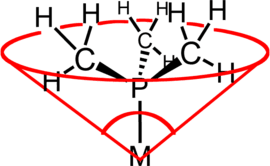Ligand cone angle

The ligand cone angle (a common example being the Tolman cone angle or θ) is a measure of the size of a ligand. It is defined as the solid angle formed with the metal at the vertex and the hydrogen atoms at the perimeter of the cone (see figure). Tertiary phosphine ligands are commonly classified using this parameter, but the method can be applied to any ligand. The term cone angle was introduced by Chadwick A. Tolman, a research chemist at Dupont. Originally applied to phosphines, the cone angles were originally determined by taking measurements from accurate physical models of them.[1][2][3]
Asymmetric cases
The concept of cone angle is most easily visualized with symmetrical ligands, e.g. PR3. But the approach has been refined to include less symmetrical ligands of the type PRR'R" as well as diphosphines. In such asymmetric cases, the substituent angles' half angles, θi/2, are averaged and then doubled to find the total cone angle, θ. In the case of diphosphines, the θi/2 of the backbone is approximated as half the chelate bite angle, assuming a bite angle of 74°, 85°, and 90° for diphosphines with methylene, ethylene, and propylene back bones, respectively. The Manz cone angle is often easier to compute than the Tolman cone angle.[4]
Variations
The Tolman cone angle method assumes empirical bond data and defines the perimeter as the maximum possible circumscription of an idealized free spinning substituent. In contrast, the solid-angle concept derives both bond length and the perimeter from empirical solid state crystal structures.[5][6] There are advantages to each system.
Application
The concept of cone angle is of practical importance in homogeneous catalysis because the size of the ligand affects the reactivity of the attached metal center. In a famous[7] example, the selectivity of hydroformylation catalysts is strongly influenced by the size of the coligands. Despite being monovalent, some phosphines are large enough to occupy more than half of the coordination sphere of a metal center.
Cone angle values
| Ligand | Angle (°) |
|---|---|
| PH3 | 87[1] |
| PF3 | 104[1] |
| P(OCH3)3 | 107[1] |
| dmpe | 107 |
| depe | 115 |
| P(CH3)3 | 118[1] |
| dppm | 121 |
| dppe | 125 |
| dppp | 127 |
| P(CH2CH3)3 | 132[1] |
| dcpe | 142 |
| P(C6H5)3 | 145[1] |
| P(cyclo-C6H11)3 | 179[1] |
| P(t-Bu)3 | 182[1] |
| P(C6F5)3 | 184[1] |
| P(2,4,6-Me3C6H2)3 | 212 |
See also
- Bite angle
- Steric effects (vs. electronic effects)
- Tolman electronic parameter
References
- 1 2 3 4 5 6 7 8 9 10 Tolman, Chadwick A. (1970-05-01). "Phosphorus ligand exchange equilibriums on zerovalent nickel. Dominant role for steric effects". J. Am. Chem. Soc. 92 (10): 2956–2965. doi:10.1021/ja00713a007.
- ↑ Tolman, C. A.; W. C. Seidel; L. W. Gosser (1974-01-01). "Formation of three-coordinate nickel(0) complexes by phosphorus ligand dissociation from NiL4". J. Am. Chem. Soc. 96 (1): 53–60. doi:10.1021/ja00808a009.
- ↑ Tolman, C. A. (1977). "Steric Effects of Phosphorus Ligands in Organometallic Chemistry and Homogeneous Catalysis". Chem. Rev. 77 (3): 313–48. doi:10.1021/cr60307a002.
- ↑ Manz, T. A.; Phomphrai, K.; Medvedev, G.; Krishnamurthy, B. B.; Sharma, S.; Haq, J.; Novstrup, K. A.; Thomson, K. T.; Delgass, W. N.; Caruthers, J. M.; Abu-Omar, M. M. (2007). "Structure−Activity Correlation in Titanium Single-Site Olefin Polymerization Catalysts Containing Mixed Cyclopentadienyl/Aryloxide Ligation". J. Am. Chem. Soc. 129 (13): 3776–3777. doi:10.1021/ja0640849. PMID 17348648.
- ↑ Immirzi, A.; A. Musco (1977). "A method to measure the size of phosphorus ligands in coordination complexes". Inorganica Chimica Acta 25: L41–L42. doi:10.1016/S0020-1693(00)95635-4. Retrieved 2009-12-04.
- ↑ Niksch, Tobias; Helmar Görls; Wolfgang Weigand (2009). "The Extension of the Solid-Angle Concept to Bidentate Ligands". European Journal of Inorganic Chemistry 9999 (9999): NA. doi:10.1002/ejic.200900825.
- ↑ Evans, D., Osborn, J. A., Wilkinson, G. (1968). "Hydroformylation of Alkenes by Use of Rhodium Complex Catalyst" (PDF). Journal of the Chemical Society 33 (21): 3133–3142. doi:10.1039/J19680003133.
